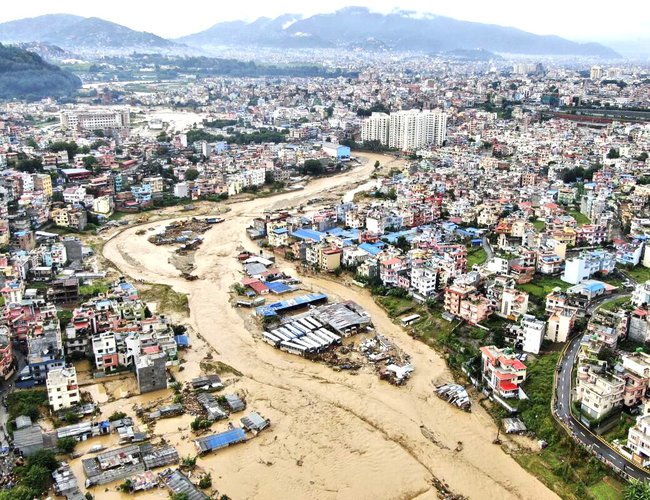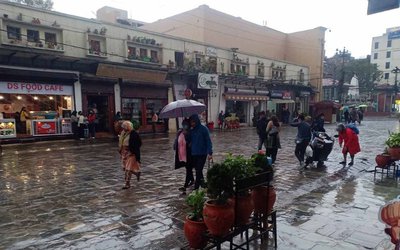
South Asia: An Epicenter of Climate Disaster
South Asia stands at the epicenter of climate-induced disasters: here, geographic extremes, dense populations, and entrenched poverty converge to create a perfect storm of vulnerability. Its climate resilience is eroded by a web of interlinked challenges, including fractured early warning systems (EWSs), unplanned urban sprawl, degraded ecosystems, marginalized populations with limited adaptive capacity, institutional fragmentation, and uneven access to climate finance. These structural gaps not only delay timely responses but deepen socio-economic inequities, placing millions in harm’s way.
From Afghanistan’s relentless droughts and frequent flash floods to Bangladesh’s devastating cyclones and progressive river erosion, the impacts are both widespread and intensifying. Bhutan grapples with GLOFs and landslides, while India’s diverse terrain faces everything from searing heat waves to cyclones causing damage in the billions of dollars. The Maldives teeter on the brink due to existential threat of rising seas, and Nepal’s retreating glaciers have undermined critical sectors like hydropower. Pakistan’s 2022 floods exposed the deadly consequences of climate inaction, while Sri Lanka’s shifting and unpredictable rainfall patterns and warming climate jeopardize food and water security. Across the region, the disproportionate burden climate change places on women, children, and indigenous peoples underscores the urgent need for promoting risk-informed, inclusive adaptation strategies and revitalizing regional cooperation.
South Asia’s Climate Policy Landscape and the Role of UNDP
South Asia has made strategic yet uneven strides in regional climate and disaster risk governance. Landmark frameworks such as the South Asian Association for Regional Cooperation (SAARC) Comprehensive Framework (2006–2015), SAARC Climate Action Plans (since 2008), and the Bay of Bengal Initiative for Multi-Sectoral Technical and Economic Cooperation (BIMSTEC) Framework (2011) laid the groundwork for cooperation in EWS, risk assessment, and resilience-building. Regional institutions like the SAARC Disaster Management Centre and ICIMOD’s Himalayan Climate Change Adaptation Program (2011) have fostered transboundary collaboration and climate-smart practices. However, limited data interoperability, poor coordination, and constrained finances continue to dilute the transformative potential of these platforms to address the rise in climate threats. At the community level, regional efforts are complemented by impactful grassroots innovations. Nepal’s community-based flood EWSs along the Karnali and Koshi rivers and Bangladesh’s Cyclone Preparedness Programme (CPP) showcase how localized systems can enhance anticipatory action. India’s Indian Himalayan Region’s Climate Adaptation Programme (2016) further underscores the value of climate-resilient farming and water governance in fragile mountain ecosystems. These initiatives reflect a growing shift toward community-anchored resilience across diverse landscapes.
UNDP has been instrumental in shaping the region’s policy architecture for climate and disaster resilience. From supporting NAPs in Bangladesh (2015) and Nepal (2016) to embedding DRR into local governance through Sri Lanka’s 2013 initiative, the influence of UNDP, in conjunction with that of UNEP, has been catalytic. The South Asia Regional Resilience Initiative (SARRI, 2020) marks a key step in driving policy convergence and institutional coherence, underscoring UNDP’s capability to advance integrated, future-ready resilience frameworks.
Breaking Point: Emerging Challenges and Bottlenecks in South Asia’s Climate Crisis
Inadequate early warning systems and communication of risk: EWSs in South Asia have made commendable strides. In particular, India enhanced cyclone tracking, Bangladesh’s CPP earned global recognition, and Nepal’s community-based flood EWS serves as a regional model. Several other countries are also advancing steadily. However, as highlighted by the 2023 WMO report, only 50% of the region's population is currently covered by effective multi-hazard EWSs, a figure well below the global target of 100% by 2027. Persistent gaps remain, especially in reaching vulnerable communities. In Afghanistan, over 70% of rural, hazard-prone areas still lack operational warnings, while the establishment of EWSs in Nepal’s remote mountain regions faces both logistical and technical hurdles. Sri Lanka’s 2021 floods exposed breakdowns in risk communication, largely due to limitations in digital infrastructure and gaps in coordination. Sophisticated systems are found in India, but many informal settlements and non-literate populations remain out of reach. Even the CPP in Bangladesh, which has received international praise, was found by BRAC and the Red Cross (2022–2023) to miss last-mile communication with women, persons with disabilities, and ethnic minorities. Bhutan’s highland communities struggle with sparse mobile coverage, and Pakistan’s 2022 floods revealed delays in converting satellite data into timely alerts. Inadequate EWSs and poor communication of risk leave millions of South Asians, specially marginalized and remote communities, unprepared for disasters, thereby increasing their vulnerability to injury, displacement, and loss of life. These gaps also erode trust in public systems, hinder timely evacuation and response, and deepen existing inequalities in disaster resilience.
Poor urban planning and unregulated development: Urbanization in South Asia has spurred economic growth and innovation across the region. Progress in infrastructure development has been particularly notable. However, the pace and pattern of urban expansion often outstrip the capacity to plan, and the resulting haphazard settlements are often highly exposed to climate and disaster risks. According to UN-Habitat (2023), over 300 million people now live in South Asia’s cities, including 130 million in informal settlements, many of which are located on floodplains, in coastal regions, and on unstable hillsides. In Bangladesh, Dhaka’s increasingly severe monsoon floods are linked to wetland encroachment and drainage congestion, with the Centre for Environmental and Geographic Information Services reporting a 60% loss in the number of water bodies over three decades. Hillside settlements in Chattogram are prone to landslides and lowland areas are frequently waterlogged. India’s urban hubs, especially Mumbai, Chennai, and Bengaluru, grapple with frequent flooding exacerbated by unchecked construction and the erosion of natural buffers. The 2023 Chennai floods, for example, displaced over 50,000 people, and Bengaluru’s loss of more than 80% of its wetlands contributed to severe flooding in both 2022 and 2023. In Pakistan, the 2020 Karachi floods illuminated serious issues with drainage, informal housing, and poor infrastructure resilience. The Urban Unit (2022) estimates that 30% of Karachi residents live in under-served informal areas. In Nepal’s Kathmandu Valley, land-use changes and drainage obstructions continue to drive urban flood risks of 2024, with NDRRMA (2023) attributing over 40% of damage to construction in hazard-prone zones. Sri Lanka’s Colombo experienced intensified flash floods in 2021 and 2023 due to development in low-lying areas (ADB, 2023). Meanwhile, rapid urbanization in Malé, Maldives, has stressed reclaimed lands and limited storm water infrastructure, and Bhutan’s Thimphu is expanding faster than it can enforce building codes. Poor urban planning and unregulated development have pushed millions of South Asians, especially those who live in informal settlements, into high-risk zones prone to floods, landslides, and other climate-induced hazards. These patterns not only increase displacement, economic losses, and health risks during disasters but also strain already fragile infrastructure, deepen urban inequality, and undermine long-term resilience.
Fragile ecosystems and resource degradation: South Asia’s rich ecosystems, from the Himalayan watersheds to the Sundarbans mangroves, are vital shields against climate risks and lifelines for millions. Despite the region’s governments having made commendable strides in conservation, afforestation, and environmental awareness, these natural systems are under great and growing pressure. UNEP’s State of the Environment Report for South Asia 2022 reveals that over 30% of the region’s land is degraded, a fact that heightens the risks of floods, drought, and landslides. In Bhutan, road construction and agricultural expansion are eroding forested slopes, triggering more frequent monsoon-induced landslides and flash floods and human-wildlife conflict is on the rise, a condition signaling deep ecological stress (Department of Forests and Park Services, 2023). Pakistan loses 0.2% of its arable land annually to erosion and salinization, and 60% of its total territory has been affected by land degradation (UNCCD, 2022). The depletion of Sindh’s mangrove forests and severe groundwater stress in Punjab and Khyber Pakhtunkhwa further undermine climate resilience. India’s biodiversity hotspots, the Northeast and the Western Ghats, face mounting threats from forest loss, saline intrusion, and extreme weather. In Bangladesh, the degradation of the Sundarbans due to shrimp farming, logging, and sea-level rise has left coastal communities more exposed during cyclones (Amphan, 2020; Mocha, 2023). In Nepal, deforestation and the unchecked extraction of sand and gravel in the Chure-Tarai belt have reduced both protection from floods in downstream regions and rates of aquifer recharge. Afghanistan has seen its forest and rangeland coverage shrink from 3% to less than 1.5% (FAO, 2023), a change that has aggravated drought conditions and increased livelihood insecurity. Sri Lanka’s Knuckles Mountain Range is losing biodiversity, and over 20% of its catchment areas are at risk from illegal encroachment (Institute of Policy Studies, 2022). The degradation of South Asia’s ecosystems is severely weakening the natural buffers that once protected communities from floods, droughts, and landslides, thereby exposing millions to escalating climate risks. As forests, wetlands, and watersheds deteriorate, rural livelihoods, food security, and water availability are increasingly in jeopardy, exacerbating poverty and displacing some of the region’s most vulnerable people.
Limited adaptive capacity of marginalized communities: Across South Asia, the resilience of marginalized groups such as subsistence farmers, fisher folk, women-headed households, ethnic minorities, and landless laborers is severely constrained despite their ingenuity in coping with climate shocks. The IPCC’s Sixth Assessment Report (2023) warns that even under moderate climate scenarios, these communities face disproportionately high risks of displacement, food insecurity, and income loss. In Sri Lanka’s central highlands, erratic rainfall and dry spells have reduced the yields of subsistence farmers and estate workers. A 2022 survey by the Hector Kobbekaduwa Agrarian Research Institute revealed that 70% of smallholder tea farmers reported that their incomes had declined over the last five years, but less than 10% of these same individuals had accessed formal adaptation support. In the Maldives, coastal erosion and saline intrusion threaten island communities reliant on fishing and tourism. The 2023 Maldives Climate Outlook highlights gaps in access to resilient infrastructure. Nepal’s Madhesi, Tharu, and Dalit communities in the Terai face recurrent flooding every monsoon season. A 2023 UNDP-supported study found that nearly 80% of women-headed households in Saptari and Bardiya districts lacked both access to credit and land tenure, a fact which has stalled recovery efforts. In India, tribal populations in Odisha and Jharkhand were among the hardest hit during the 2023 heat wave, which disrupted schooling and rain-fed agriculture. National adaptation frameworks do exist, but their implementation at the local level is uneven. In Bangladesh’s Satkhira and Kurigram districts, recurring cyclones and frequent crop failures have forced over 60% of climate-affected women to adopt precarious coping strategies such as informal migration, early marriage, food rationing, and high-interest borrowing (BRAC, 2023). In Pakistan’s Gilgit-Baltistan and Balochistan regions, glacial retreat and limited infrastructure compound vulnerabilities, while in Afghanistan, where over 70% depend on rain-fed agriculture, OCHA (2023) notes that access to drought-resilient technologies is limited. Limited adaptive capacity has rendered many marginalized communities in South Asia acutely vulnerable to climate shocks, forcing them to adopt harmful coping strategies. Without targeted support, these groups face deepening cycles of poverty, displacement, and loss of livelihoods, all states that will undermining both social cohesion and long-term resilience.
Institutional and policy fragmentation: South Asia has made significant strides in promulgating effective climate policies, with countries rolling out ambitious frameworks such as India’s national and state action plans on climate change, Bangladesh’s Climate Change Strategy and Action Plan (2009), Pakistan’s Climate Change Act (2017), Nepal’s National Adaptation Plan (2023), Maldives’ National Adaptation Plan of Action (2007), and Afghanistan’s Peace and Development Framework (2017). These documents reflect strong political commitment and an evolving climate governance landscape. However, translating national policies into cohesive, well-coordinated action on the ground remains a key challenge. In India, while policies are robust, a 2023 report by the Centre for Science and Environment flagged weak inter-ministerial coordination, especially in areas like urban flood management in Mumbai and Kolkata, as a potential problem. Nepal’s shift to federalism created room for local leadership, yet IIED (2022) noted that local governments in the Bagmati and Gandaki provinces often lack the technical and financial capacity to avoid project duplication. Similarly, Pakistan’s 2022 floods exposed a lack of coordination between federal and provincial authorities. The ADB (2023) also emphasized the need for more integrated planning across the region, especially in critical sectors such as agriculture and water. Similarly, a 2022 IWMI study found that Bangladesh's efforts in water governance suffer from inter-agency overlaps in regions such as Khulna despite the country’s proactive climate stance. In Sri Lanka, multi-agency involvement in disaster response, as was seen during the 2020 monsoons, has been beneficial, though overlapping mandates have occasionally delayed action. Decentralized island governance in the Maldives has enabled targeted planning, but UNDP (2022) identified coordination bottlenecks among key sectors like tourism, fisheries, and the environment. Afghanistan’s climate ambitions are strong and are backed by global financing, but a 2023 Oxfam report highlighted the need to empower local governance units, particularly those in the provinces of Kabul and Herat, to embed resilience into rural development. Institutional and policy fragmentation has hampered the delivery of timely and integrated climate actions at the local level, often leading to the duplication of efforts, inefficient use of resources, and delays in critical responses. As a result, communities, especially those in high-risk zones, experience uneven access to services, infrastructure, and adaptation support, leaving them highly exposed to climate and disaster impacts.
Financial constraints and access to climate finance: South Asia’s commitment to climate action is evident in its strong policy frameworks and active engagement with global finance mechanisms such as the GCF and GEF. Countries across the region are increasingly integrating climate finance into their national strategies. Despite this momentum, consistent and equitable access to climate finance remains a significant barrier, and technical and procedural hurdles persist. A 2023 ADB report noted that many South Asian countries struggle to prepare bankable proposals that meet international fiduciary and safeguard standards. In Afghanistan, institutional instability continues to limit donor engagement and restrict access to climate funds. Pakistan, as is highlighted by the 2022 World Resources Institute, secured full financing for only 30% of its adaptation projects, a fact which points to weak institutional coordination. Bhutan’s strong leadership in climate matters is tempered by its narrow economic base and over-reliance on hydropower, both characteristics that limit its ability to fund mountain adaptation efforts (World Bank, 2023). The Maldives, despite its progressive 2019 Climate Change Act, had accessed just 40% of the funds it was eligible for by 2022 (UNEP). It was in part constrained by its limited institutional and technical bandwidth. India has effectively aligned national priorities with climate finance platforms but states like Uttarakhand and Bihar find it difficult to develop proposals and absorb funds (CII-ITC, 2023). Bangladesh benefits from the Bangladesh Climate Change Trust Fund, yet a 2023 UNDP report identified gaps in its ability to decentralize technical capacity and ensure fiduciary compliance at the local level. Nepal, too, struggles with institutional readiness. A 2022 assessment by the Climate Change Knowledge Management Center emphasized that Nepal has weak rural project management systems and limited capacity to optimize its use of funds. Sri Lanka’s economic crisis has compounded its problems. In particular, its macroeconomic instability and institutional fragmentation have reduced investor confidence and stalled large-scale climate projects (ADB, 2022). Limited and uneven access to climate finance has left vulnerable communities in South Asia without the resources they need to build resilience, adapt to climate impacts, and recover from disasters. As a result, local adaptation efforts are often underfunded, delayed, or poorly implemented a fact which widens existing socio-economic disparities and increases exposure to climate-related risks.
The Road to Resilience: What’s Next?
To strengthen regional resilience, South Asia must urgently address systemic vulnerabilities by embedding key core issues into collaborative frameworks. Institutions such as SAARC and BIMSTEC should do more than simply convene. They should enable joint EWSs that are accessible to remote and marginalized communities, supported by real-time, interoperable data and inclusive risk communication. Regional platforms must tackle institutional fragmentation through harmonized policy dialogues and pooled financing that channels resources to where they are needed most, such as under-served regions and transboundary ecosystems. Investments in climate-resilient infrastructure corridors, particularly in high-risk urban zones, should be paired with strong land-use governance to curb unregulated development. Recognizing that degraded forests, wetlands, and watersheds not only intensify climate hazards but also threaten the livelihoods of millions, regional collaboration must also prioritize ecosystem restoration, especially in the Sundarbans and in Himalayan watersheds. Moreover, scaling up nature-based solutions and promoting climate-smart agriculture will require robust mechanisms of knowledge exchange and shared research agendas that are accessible to practitioners and communities across borders.
At the national level, climate governance must be fully integrated into development planning across multiple sectors, from water and agriculture to health, education, and urban management, with a focus on decentralizing authority and resources to empower local governments and frontline actors. The strengthening of EWSs must be accompanied by inclusive risk communication strategies that rebuild trust and enable timely evacuations, especially of women, indigenous groups, and informal settlements. Governments should invest in building climate finance readiness by streamlining the development of proposals, ensuring fiduciary transparency, and developing absorptive capacity at the sub-national level. Addressing the deep-rooted vulnerabilities of marginalized groups requires adaptation budgets that prioritize social protection, land tenure, credit access, and livelihood diversification. Embedding gender equality, indigenous knowledge, and community-based adaptation into national strategies will make resilience planning more effective and socially just, thereby ensuring that those most affected by climate change are also key agents of transformation. By putting equity, coordination, and local empowerment at the heart of climate governance, South Asia can transform systemic vulnerabilities into a foundation for inclusive, cross-border resilience.
Dr. Dhruba Gautam is an “Independent Evaluator and Consultant” with expertise in energy, natural resource management, climate resilience, and disaster risk reduction across the Asia-Pacific and Caribbean regions. The insights shared in this article are based on his extensive multi-county complex evaluations in the South Asia region. For collaborations or inquiries, he can be reached at drrgautam@gmail.com
- Climate Vulnerability And Resilience In West Asia: A Call To Strengthen Climate Governance And Accelerate Green Energy Investments
- Apr 21, 2025
- Evaluation of Energy Transitions in Southeast Asia: Key Successes, Emerging Gaps and Major Takeaways for Adopting Green Energy
- Apr 14, 2025
- The Caribbean's Climate Crisis: A Call for Urgent Action
- Mar 14, 2025
- Renewable Energy-Sector Policy Initiatives And UNDP’s Role In The Pacific Region: The Path Ahead
- Mar 04, 2024
- Operationalization Of Nepal’s National Adaptation Plan: Institutionalizing A Monitoring, Review, And Reporting System Is Crucial
- Jan 09, 2024














